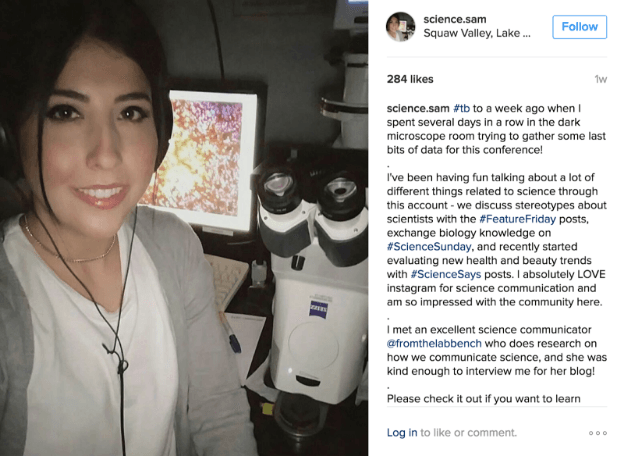#SciFund Challenge Class
Part 6: Examples of Innovative #SciComm on Instagram
Experiential Science Communication on Instagram: Take the Viewer With You
Instagram offers scientists and science communicators a unique opportunity to share their work and promote science learning among broader audiences. For example, Instagram-ers often create videos of chemistry experiments, tagged with various #chemistry related hashtags, to teach and demonstrate chemical reactions that many people typically don’t have access to.
To further promote public engagement with science, Instagram users who post science-related content can invite people to “ come on a journey ” with them in the discovery of science in the lab or field. The selfie or the personal live broadcast is particularly well-suited to this, because viewers feel that they are there with you , having a conversation with you, and it transports them into a world of science they might never otherwise experience.
Scientists on Instagram can also invite viewers to participate in creating scientific knowledge. For example, researchers at Louisiana State University started an Instagram account for their citizen science project Fox Finders . Through their Instagram feed , they encourage Louisiana residents to post pictures/videos of red foxes sighted in local areas in order to build a map of where red foxes live in Baton Rouge (see below for one of their cute fox posts).
Share Science In the Making
To promote public understanding of science, we encourage you to not only post information about the results of your scientific work on Instagram, but images/photos of science-in-the-making . Audiences increasingly expect to be “brought along on the journey of scientific discovery” as opposed to simply being educated about the final products of science.
Try to post pictures of what science looks like for you on a daily basis. You can post visuals of methodologies, equipment you use in the lab, diagrams of research ideas you have, or even talk about the struggle of failed experiments on Instagram. If you are an undergraduate student, you can post visuals from your science lab courses and reflect on what you are learning. You can even post visuals of what it looks like to be YOU, as a scientist, on a daily basis – selfies from the field, selfies conducting data analysis , selfies from scientific conferences, selfies during late-night study sessions, etc. @science.sam does an excellent job of sharing her daily science life via posts and stories (more on that later).

With Instagram, you have the ability to control your public perception. Recently there has been a movement among communities of scientists and science students online to create visual portrayals of scientists that counter stereotypes and to offer audiences a view inside their lives as scientists. The science “selfie” can actually help to make scientists and students of science more relatable to people outside of the scientific community. Invite people into your day-to-day life through instagram. This can help more people see themselves as potential scientists.
Science and Art
Check out the very popular hashtag #sciart on Instagram and you will be open to a world of wonder. You too can join the #sciart party! You just need to get creative about how your science, your scientific research, or what you study as a science student could be visualized . Here’s just one example of the great visuals you find on #sciart.
Do you work with living organisms in the lab or field? You could create videos of them to share with others on Instagram. ( Note: It’s best to share these in a positive way, as opposed to highlighting research done on animals such as mice that some non-scientists might find issues with. ) Do you work with colorful solutions or other visually interesting materials you could photograph? For example, here’s a geologist showing some neat up-close photographs of sand.
Do you have access to a microscope you could use to share photos of your science on a micro-level, or telescope images to share your astronomy research? ( Note: All NASA images are public domain, and you can share these with credit on your Instagram account ). Can you create illustrations (see below), diagrams or figures that you could share on Instagram to represent your scientific research or what you are learning in your science classes? Do you conduct any interesting scientific processes, procedures or experiments that might be interesting to video, timelapse video, etc.?
Even if you don’t have visuals you’ve created yourself of your science, scientists can now easily collaborate with artists to transform their science into visuals that broader audiences will engage with. Collaborate with local artists, your friends in the art department at your university, or reach out to artists online to explore working with them to visualize your science.


